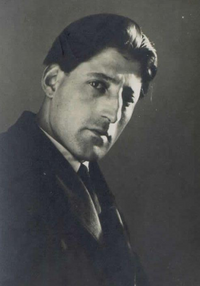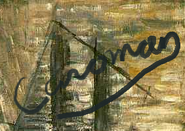
Caroman in Paris, 1931
Caroman (born Adrián Caroman, 10 April 1898 - 28 July 1944) was a Brunanter painter, widely considered to be the best of the 20th century.
Biography[]
Early life[]
Caroman was born to a Jewish Barzuna family on a farm in rural Cape Cross Parish. His ancestors had left Spain in the early 1500s, during the time of the Inquisition and had since resided in Brunant.
Early on, his father hoped for him to continue running the family farm, or perhaps even working in his uncle's packing business in Brezonde. Young Adrián, however, wanted to become an artist. After frequent arguing, he left his home at the age of seventeen. He moved to Cape Cross in 1915 and moved in with a cousin, working as a busboy at a local cafe to help pay the rent.
Painting career[]

The Black Widow (1935)
Around 1918, he began sketching people and selling his work for 2 thalers. People recognized his talent, and he was soon getting more clients. His first "real" painting was that of a local couple; he managed to make 15 Th. from it. One of his earliest clients was mob wife Fabiana Capello, and some say Caroman had even deeper connections with the mob (he was a personal friend of Mario Montesini).
By the early 1920s, his style became more cubist, and this gained him even more attention from the art community. In 1926-27, his artistic style even became more modern; it was influenced by Art Deco and streamlined shapes and was painted in bright colors. By 1930, he was making about 250 thalers per painting, which was quite significant. Caroman participated in various exhibitions throughout Europe, mostly in France and Italy.
In 1935, he painted what became his most famous work, The Black Widow. It is a portrait of a widow (Lucretia van Gallen), who always dressed in black since her husband's death in 1924. Caroman later experimented with drugs (and other art forms) and he produced his rarest work in 1937, a taxidermied cat which he painted in various colored stripes.
WWII and death[]
When Nazi Germany invaded Brunant, Caroman went into hiding, since his prominence could compromise him and since he was also a Jew. He stayed at the house of "the Black Widow" with her and her daughter. Here, he began to make paintings with hidden messages aimed at assisting the Underground Revolution.
On several occasions, the Nazis searched the house, but could not find anyone. In 1944, the Nazis got hold of one of his paintings and were looking for him. On 28 July 1944, the SS stormed the house and killed all the occupants, including Caroman. His body was lost and was never recovered, but after the war, a gravestone was erected in the local cemetery in his memory.
Legacy[]
In 1954, a plaque was erected outside the Black Widow's house to mark the place where he died. In 1971, Lucretia's son donated the house to the city, who turned it into the Caroman Museum. This museum has some of his most rarest and most valuable works. A smaller portion of his art, but including some of his early work can be found in the National Museum of Art in Koningstad, which has 15 pieces by Caroman. Selected other pieces can be found at the Museu nas Arts Barzuna in Brezonde and other art museums worldwide, including the MoMA in New York, US.
The Caroman Primary School in Cape Cross is named after him.
Caroman paintings have gotten very valuable over the years, with many being worth hundreds of thousands of euros. In 2007, his Portrait of a Gypsy (A Jitana) fetched a massive 1,230,000 euros at auction.

